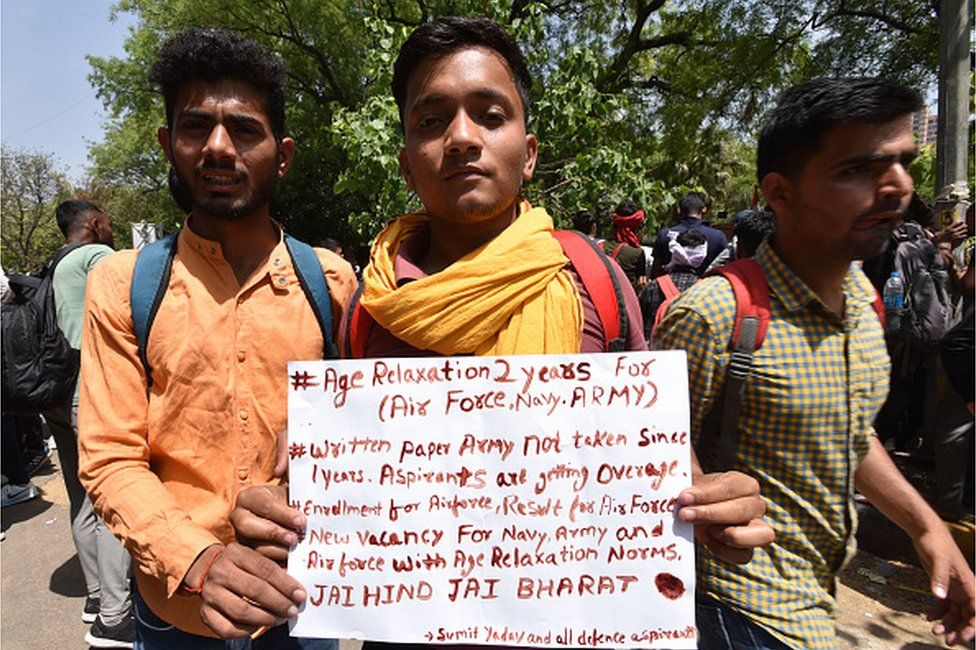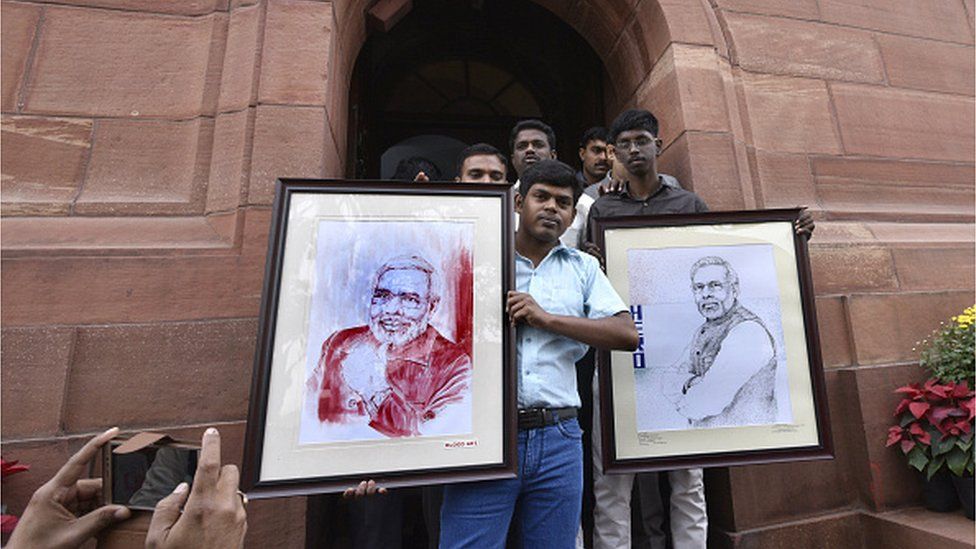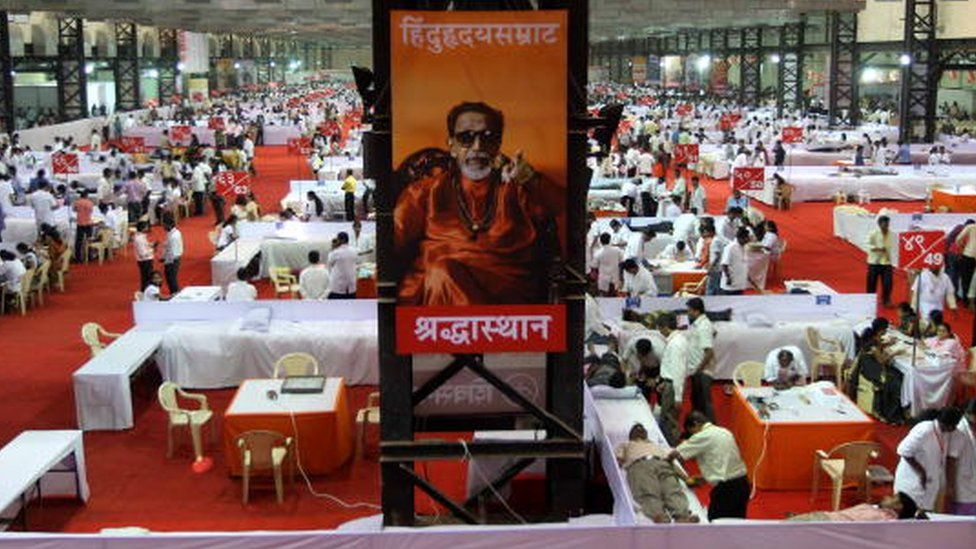Protest, love, art: The unusual uses of blood in India
 GETTY IMAGES
GETTY IMAGESFor more than a decade, a non-profit organisation in India has been creating paintings using blood donated by its members.
More than 250 such artworks honouring revolutionaries and martyrs have been made by the Delhi-based Shaheed Smriti Chetna Samiti (Society to Awaken Remembrance of the Martyrs). They are usually given away to ashrams (spiritual retreats) and small museums and displayed in exhibitions.
"Blood is rich in symbolism. We make our paintings in blood to instil patriotism among people. Love for the country is diminishing among children," Prem Kumar Shukla, who heads the non-profit group, told me.
Its founder, Ravi Chander Gupta, a retired school principal, donated blood for 100 paintings until his health began failing. "I started this to attract the public and get their attention. People are more interested if the portraits are in blood. Blood creates sentiments," Gupta, who died in 2017, once told interviewers.
Mr Shukla, his successor, is a doughty 50-year-old school teacher and poet. He claims to have donated blood for 100 paintings alone. Donors like him go to a local lab where their blood is extracted, mixed with anti-coagulants - human blood becomes sticky when its clots - put into 50ml bottles, and given to a bunch of artists. Usually 100ml of blood is enough to make two to three paintings, Mr Shukla says. "I donate blood four times a year for our paintings."
 GETTY IMAGES
GETTY IMAGESThe "blood paintings", says Mr Shukla, were inspired by the persuasive rhetoric - "give me blood and I will give you freedom" - of independence hero Subhas Chandra Bose, known as "Netaji" (respected leader). Bose raised an army of Indian soldiers to fight the British.
The politics of blood runs deep in India. Mahatma Gandhi endlessly monitored his blood pressure and had a "preoccupation with blood", write Jacob Copeman and Dwaipayan Banerjee in Hematologies, a book which examines the connections between blood and politics.
Blood was also an anti-colonial metaphor. Gandhi, the world's most famous pacifist, hoped Indians would "possess blood that could withstand the corruption and poison of colonial violence". A blood-stained cloth worn by the leader on the day he was murdered in 1948 is among the artefacts on display in a museum in Madurai in southern India. "Metaphors of blood - its extraction and sacrifice - are inescapably rife in Indian political discourse," note Mr Copeman and Mr Banerjee.
Not surprisingly blood is a metaphor for loyalty and sacrifice. Ardent supporters of Prime Minister Narendra Modi have drawn his paintings in their blood. Blood is also a mode of protest: In 2013, more than 100 women from villages in Gujarat wrote a letter to Mr Modi in blood, protesting against plans to acquire their land to build a new road. They said they had written postcards, and the prime minister hadn't replied. A teenage girl in Uttar Pradesh state wrote a letter to officials with her blood, seeking justice for her mother who was burnt alive.
 GETTY IMAGES
GETTY IMAGESProtesters write petitions in blood demanding higher wages, hospitals and schools and opposing laws that they believe are draconian. Some also write love letters in blood to get attention. And people also routinely complain that politicians "suck the people's blood" as a metaphor to highlight issues like corruption and red tape.
In 2008, survivors of the 1984 gas tragedy in Bhopal - the worst industrial accident in India's history - walked 800km (497 miles) to Delhi and sent to then prime minister Manmohan Singh a letter written in their blood to draw his attention to their health and rehabilitation problems.
During demonstrations in the oil-rich state of Assam in 1980, a 22-year-old man used his own blood to write protest slogans on the streets of the capital, Guwahati. "We will give blood, not oil," read one of the slogans.
The street, reported a newspaper, "metamorphosed into a place of pilgrimage where the agitators started lighting earthen lamps, incense sticks and organised devotional prayers".
In 1988, the Communist Party of India (Marxist) asked its supporters to sell their blood to raise money to build a power plant in West Bengal following a funding dispute with the federal government - much of the collected blood had to be eventually destroyed because of lack of storage space, and the plant was completed with a Japanese loan. Around the same time, a group of donors in Kolkata (then Calcutta) sold blood to support a financially impoverished medical institution. (Selling blood was outlawed 10 years later.)
 GETTY IMAGES
GETTY IMAGESPolitical parties organise blood donation camps to gain public attention. Supporters donate to gain advancement. One blood bank professional told the authors of Hematologies that camps organised by political parties were "terrible because there's no other motivating factor than 'I am trying to please the leader'".
Clearly, blood is a useful symbol. "Blood is associated with purity of caste. Also historically, writing in blood has been a very male thing. Purity related to caste and gender in the form of maleness are the two main forms of social expression in India. Blood is also seen as the highest form of loyalty," says Sanjay Srivastava, a sociologist. In modern-day India, however, women have used blood to break "taboos" around menstruation.
In the end, blood gains you instant attention and recognition.
In 2004, a karate teacher in Chennai (then Madras) painted 57 portraits in his blood of the late Jayaram Jayalalitha, then chief minister of Tamil Nadu state, of which the southern city is the capital.
Shihan Hussaini needed a plot of land for a karate school, and sought an appointment with the chief minister. "She brought me to her residence and promised me a million dollars [for the plot]," Mr Hussaini told the authors of Hematologies. Blood art, he said, was a "tool of propaganda, communication and influencing decision making".
No comments:
Post a Comment